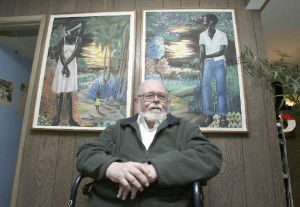The two paintings that hang in the entryway of Bob Olsen’s Bellevue home aren’t for decor — they’re a legacy that soon will be passed on again.
Olsen, a retired Mercer Island school counselor, acquired them more than 20 years ago during a Christian missionary trip to Haiti. Every few days, the artist, Emile, would ride his wobbly bicycle fastened with a variety of his paintings to the mission, Olsen recalled.
“I was particularly impressed by two of his paintings that carried a message,” Olsen said, adding that after the third visit, the artist was convinced that Olsen should have the paintings. “However, I had very little money and could hardly afford to buy them.”
The leaders at the mission negotiated a trade: Emile’s paintings for Olsen’s light blue short-sleeved shirt (just like the man in one of the paintings) and a pair of black linen shoes.
“The artist saw — and I see — a real legacy for these paintings because months before, the people of Haiti had a bloody revolt,” he said.
He had gone to Haiti in 1986, the summer after the Haitian people overthrew the Duvalier dictatorship.
Olsen shook his head as he recalled the events that led to the overthrow.
The dictatorship began in 1957 with the election of Francois Duvalier, the man known as Papa Doc. He and his son, Jean-Claude (Baby Doc), ruled Haiti for nearly 30 years.
“Papa Doc was highly educated as a medical doctor, but he was a ruthless dictator,” Olsen explained. Baby Doc, who became dictator after his father’s death, was “weak” and controlled by the military police named the Toton Macuse.
After the people’s revolt ousted Baby Doc and forced him and his wife to flee into exile in 1986, the people hunted down and murdered the Toton Macuse. Haiti became a less fearful country, he said, and missionaries from the United States and Europe came to improve schools, orphanages and hospitals.
It wasn’t long before Olsen arrived. He had the chance to see the torn country, including the very home that Baby Doc had lived in. It was just rubble, he said.
“As the artist indicated, he was excited because his country was free of dictatorship,” Olsen said.
One of the paintings depicts a young Haitian man who stands before an image of a little boy flying a kite. Small black birds on the horizon fly toward the boy under a warm sun. By contrast, the other painting shows a young Haitian woman with a tear rolling down her cheek before an image of a little girl, laboring down a path with a heavy basket on her head under a hot sun. On the horizon, small black birds fly away from her.
The paintings illustrate the people’s mixed emotions, he said. Haitians may no longer be ruled by an oppressive dictatorship, but criminal gangs have ensued.
“The dictator was a terrible dictator, but some people would almost like to go back to a dictator again, when they had security.”
Author and Haitian native Edwidge Danticat has written about the gang violence that her country faces. After she wrote her first book, “Breath, Eyes, Memory,” in 1994, Olsen wrote to the publisher. Eventually, the letter made its way to Danticat, and they have been in correspondence ever since.
At one point, Danticat wanted to buy Olsen’s paintings, but they are not for sale, he said.
However, he will soon give them to her.
“I have wanted to give them to her for a long time,” he said. “I’m an old man, and I’ve recently been diagnosed with cancer. Once I’m gone, nothing’s going to be done with these pictures, and they have a legacy to them.”
Olsen admires Danticat — who he refers to as the primary advocate of Haiti — for speaking out about her country.
Danticat has been featured in the New York Times, Time Magazine, Seattle’s Real Change and on “Oprah.” Her latest book, “Brother, I’m Dying,” is an autobiographical account of her uncle, a minister in Haiti whose life was threatened by criminal gangs. The book tells of his trip to the United States, where he sought political refuge, and highlights the Haitian diaspora, the Duvalier regime and the United States immigration policy.
Last November, Danticat presented her book at the Elliot Bay bookstore in Seattle, where Olsen met her for the first time.
“She’s quite a young lady,” he said, adding that her books are very moving.
Danticat is ready to receive the paintings, and Olsen will soon ship them out to her Florida home.
“I’ve always known they have a special meaning and a special legacy,” Olsen said of the paintings, which he sees as an inspiration for the people of Haiti to have a future of peace and security. “They belong in her possession.”



